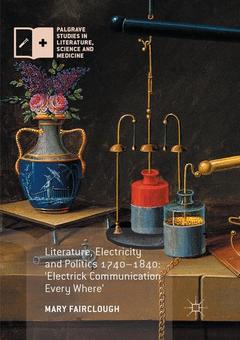Description
Literature, Electricity and Politics 1740–1840, 1st ed. 2017
‘Electrick Communication Every Where’
Palgrave Studies in Literature, Science and Medicine Series
Author: Fairclough Mary
Language: English
Subjects for Literature, Electricity and Politics 1740–1840:
Keywords
Enlightenment; Modernity; Science; Faith; Nineteenth Century; Eighteenth Century; Revolution
Literature, Electricity and Politics 1740-1840
Publication date: 07-2018
Support: Print on demand
Publication date: 07-2018
Support: Print on demand
Literature, Electricity and Politics 1740-1840
Publication date: 04-2017
Support: Print on demand
Publication date: 04-2017
Support: Print on demand
Description
/li>Contents
/li>Biography
/li>Comment
/li>
This book investigates the science of electricity in the long eighteenth century and its textual life in literary and political writings. Electricity was celebrated as a symbol of enlightened progress, but its operation and its utility were unsettlingly obscure. As a result, debates about the nature of electricity dovetailed with discussions of the relation between body and soul, the nature of sexual attraction, the properties of revolutionary communication and the mysteries of vitality. This study explores the complex textual manifestations of electricity between 1740 and 1840, in which commentators describe it both as a material force and as a purely figurative one. The book analyses attempts by both elite and popular practitioners of electricity to elucidate the mysteries of electricity, and traces the figurative uses of electrical language in the works of writers including Mary Robinson, Edmund Burke, Erasmus Darwin, John Thelwall, Mary Shelley and Richard Carlile.
Introduction. Electricity, spectacle and figuration.- Chapter 1. Experiment, aether and the soul of the world.- Chapter 2. Electricital medicine, feeling and eroticism.- Chapter 3. Animal electricity, vitality, and revolution.- Chapter 4. Electrochemistry, matter and life.- Epilogue. Michael Faraday and a new electrical era.- Illustrations.- Bibliography.- Index.-
Mary Fairclough is a Lecturer in the department of English and Related Literature and the Centre for Eighteenth Century Studies at the University of York, UK. She is the author of The Romantic Crowd: Sympathy, Controversy and Print Culture (2013), and various articles on the intersection between literature, science and politics in the eighteenth century.
Covers a broad historical period, but is also informed by close readings of textual and visual examples Takes an innovative approach, using the language of electricity to demonstrate the connections between philosophical, political and literary discourse in the period Takes an interdisciplinary approach, weaving together cultural histories of science, histories of political discourse, and formal literary analysis
© 2024 LAVOISIER S.A.S.




